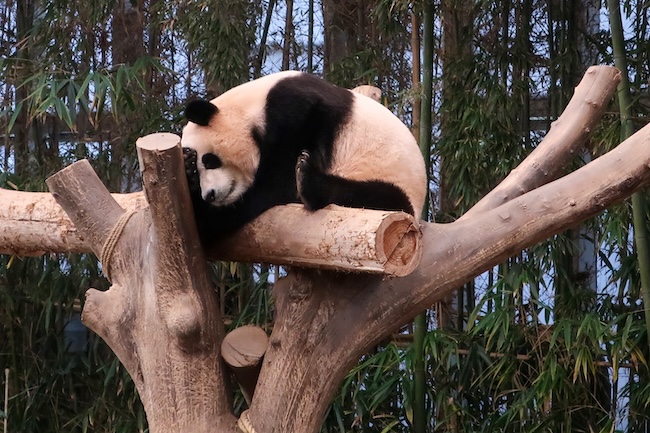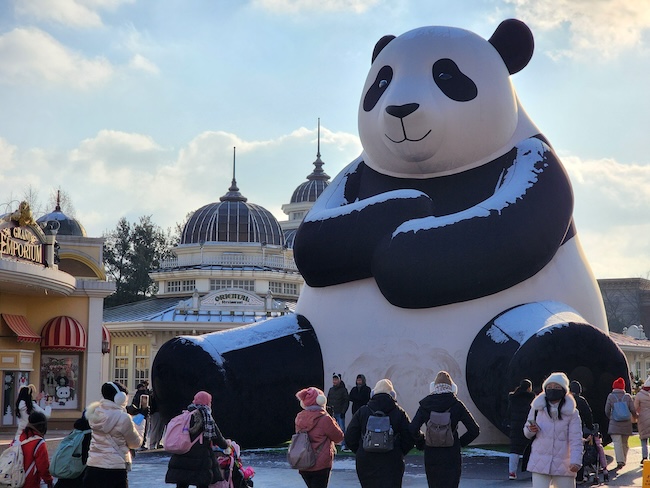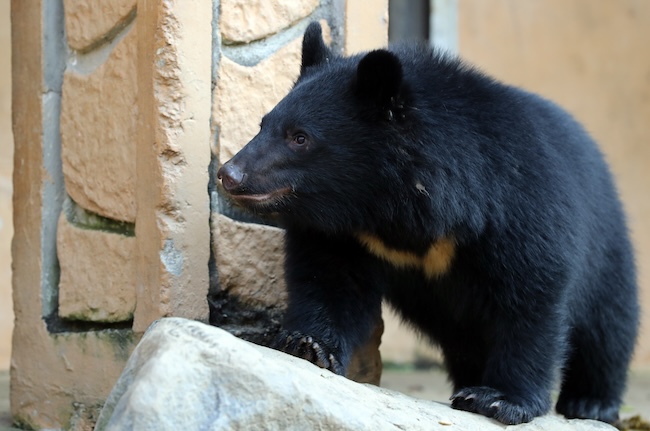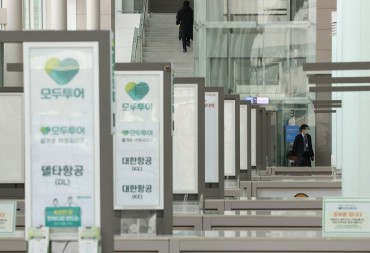
The Bao family has played a crucial role in raising awareness about endangered species and conservation efforts. (Image courtesy of Yonhap)
YONGIN, Dec. 22 (Korea Bizwire) – At the Everland theme park in Yongin, a giant statue of Fu Bao, the famous panda with popularity surpassing that of celebrities, marks the entrance. Despite the cold temperatures of around minus 5 degrees Celsius on December 20, crowds flocked to Panda World in Everland to meet Fu Bao and his family.
On this chilly afternoon, Fu Bao was spotted in a contemplative pose atop a tall tree, drawing a flurry of camera clicks. Across the way, another giant panda, Lu Bao, was seen chewing bamboo and also receiving a similar amount of attention.
Kang Cheol-won, a zookeeper often referred to as ‘Grandpa Fu Bao’, revealed in a recent broadcast that Panda World attracts about 7,000 to 8,000 visitors daily. Officials at Everland Zoo also acknowledged the significant revenue and joy the Bao family brings to the zoo.
Apart from being a source of entertainment, the Bao family has played a crucial role in raising awareness about endangered species and conservation efforts. The impending return of Fu Bao to China has led many to learn about the Convention on International Trade in Endangered Species of Wild Fauna and Flora (CITES).

At the Everland theme park in Yongin, a giant statue of Fu Bao, the famous panda with popularity surpassing that of celebrities, marks the entrance. (Image courtesy of Yonhap)
Since pandas were listed under Appendix I of CITES in 1984, China has shifted from gifting pandas to loaning them to international zoos.
Fu Bao, who will turn four next year and is reaching the age of mating, is scheduled to return to a panda sanctuary in China as early as February or March next year. However, due to the COVID-19 pandemic, several pandas already of mating age have been unable to return to China, making the timing of Fu Bao’s return uncertain.
Everland Zoo has long expanded its role from a place of amusement to a research and conservation institute for endangered species. Of the 119 animal species in the zoo, 73 (61%) are listed as endangered under CITES. Everland Zoo is also designated as an ‘ex-situ conservation organization’ by the Ministry of Environment.
Recently, the zoo has fulfilled its role as a conservation organization. For instance, a pair of injured cranes rescued in 1996 from Paldang Lake in Namyangju are residents of the zoo.

These cranes, considered natural monuments and endangered species, miraculously hatched offspring in 2020, 24 years after being rescued. (Image courtesy of Everland)
These cranes, considered natural monuments and endangered species, miraculously hatched offspring in 2020, 24 years after being rescued. The well-maintained environment in the zoo is credited for their successful breeding at an advanced age.
The offspring of these cranes are currently being prepared for release into the wild, with a focus on their adaptation to natural habitats.
South Korea’s endangered species restoration projects, led by the government, have shown progress. According to the third Natural Park Basic Plan, restoration projects for three endangered wild animal species and thirteen wild plant species have been conducted.
The Asiatic black bear population has grown to about 70, while the numbers of long-tailed gorals and foxes have each increased to around 100, marking the success of these restoration efforts.
Zoos are facing a transformation once again. With the recent amendment of the Act on the Management of Zoos and Aquariums, the system has changed from registration to licensing, making it harder for zoos and aquariums to operate without proper conditions tailored to the animals’ needs.

Although bear importation was banned in 1985 due to international criticism, bear farming remained legal for over 40 years. (Image courtesy of Yonhap)
Activities like riding, touching, or feeding animals for entertainment purposes have been prohibited, although exceptions for educational activities with permission remain. This change signifies a shift in how animals are treated, moving away from being seen as mere entertainment.
With the amendment, it has also become illegal for non-zoological institutions to display wild animals, a measure that is expected to reduce indiscriminate importation of wildlife.
Korean society is currently grappling with the consequences of treating wild animals as commodities. From 1981 to 1985, Korea allowed the importation and breeding of bears, an endangered species, to boost farm incomes.
Although bear importation was banned in 1985 due to international criticism, bear farming remained legal for over 40 years. However, with the decline in the popularity of bear bile, many farmed bears have been left in poor conditions, leading to repeated bear escape incidents.
An amendment to the Wildlife Protection Act, prohibiting bear farming, passed the National Assembly on December 20. The remaining farmed bears are set to be moved to sanctuaries starting from 2026, ending 45 years of bear farming driven by human greed.
M. H. Lee (mhlee@koreabizwire.com)






